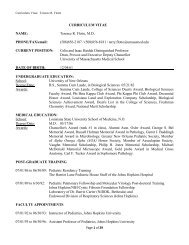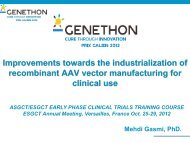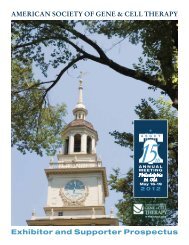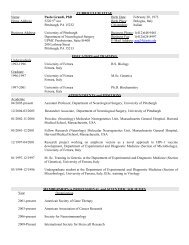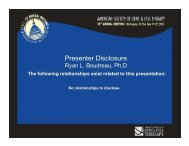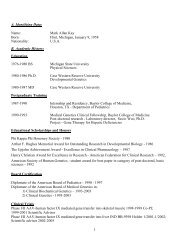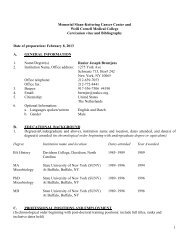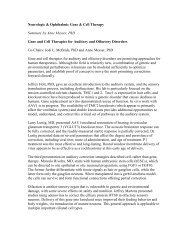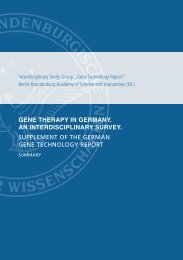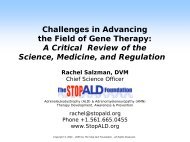FINAL PROGRAM - American Society of Gene & Cell Therapy
FINAL PROGRAM - American Society of Gene & Cell Therapy
FINAL PROGRAM - American Society of Gene & Cell Therapy
- No tags were found...
You also want an ePaper? Increase the reach of your titles
YUMPU automatically turns print PDFs into web optimized ePapers that Google loves.
13 th AnnUAL MEETing | Washington, DC USA May 19-22, 2010 59Program ScheduleScientific Symposium 31510:30 am - 12:30 pmRoom: Marriott Ballroom Salons 2 & 3<strong>Gene</strong>tic Modification <strong>of</strong> Stem <strong>Cell</strong>s for Therapeutic ApplicationsChairFrederic D. Bushman, PhDSpeakersChrist<strong>of</strong> von Kalle, MD PhDThe Clonal Distribution <strong>of</strong> Insertion Site RepertoiresRetroviral vectors have been successfully used for the correction <strong>of</strong> inherited immune diseases in clinical trials. However, qualitative and quantitative in vivo monitoring <strong>of</strong>gene modified hematopoiesis in several clinical gene therapy trials revealed that vector induced side effects, ranging from subtle and not clinically obvious effects to clonaldominance and, rarely, leukemogenesis, have to be considered.Clonality data on oncoretroviral and lentiviral clinical gene therapy trials (i.e. CGD, SCID, WAS, ALD) show that integration site distribution is non-random and mayinfluence cellular gene expression, thus inducing changes in the clonality <strong>of</strong> the hematopoietic repopulation. Incorporation <strong>of</strong> next generation sequencing technologiessubstantially improve in depth analyses and monitoring <strong>of</strong> individual and global clonal contribution in a hitherto unexpected resolution. Prospective monitoring <strong>of</strong> vectorintegration sites in clinical gene therapy studies is feasible, can detect side effects <strong>of</strong> gene therapy at the clonal level, and may help to gain new insights into the basicmechanisms leading to specific clonal behaviour in vivo. Genome wide insertion studies will allow to improve the safety and performance <strong>of</strong> viral and non-viral integratingvector systems.Matthew H. Porteus, MD, PhD<strong>Gene</strong> Targeting with Zinc Finger Nucleases in Primary <strong>Cell</strong>s<strong>Gene</strong> targeting by homologous recombination has the potential to be both a safer and more efficacious approach to gene therapy. Therapeutically relevant rates <strong>of</strong> genetargeting have been achieved by using zinc finger nucleases in a variety <strong>of</strong> tissue culture cell lines and some primary human cells. We now demonstrate that therapeuticallyrelevant frequencies <strong>of</strong> gene targeting by homologous recombination can be achieved in primary cells and that these modified cells can be successfully transplantedback into a recipient. The demonstration that primary cells can be isolated, precisely modified ex vivo and then transplanted back into a recipient mimics the strategy weare working towards in humans as a cure for patients with monogenic diseases.Frederic D. Bushman, PhDHIV DNA Integration: Mechanism and ConsequencesThe lecture will cover integration by HIV and HIV-based vectors. Recent results from gene therapy trials will be presented. The lecture will also cover development <strong>of</strong>improved new methods for integration site isolation and analysis.Ko Mitani, PhDChromosomal Manipulation <strong>of</strong> Human Pluripotent Stem <strong>Cell</strong>s using Adenoviral VectorsIn order to fully utilize human induced pluripotent stem (iPS) cells and embryonic stem (ES) cells for basic research and clinical applications, it is essential to developefficient methods for homologous recombination (HR) in these cells. We have shown that, by delivering gene-targeting cassettes using helper-dependent adenoviralvectors (HDAdVs) into human ES/iPS cells, gene knock-in/-out has been efficiently achieved at both transcriptionally active and inactive loci. On average, one out <strong>of</strong>2 - 20 x 105 infected cells was homologous recombinant. The efficiencies <strong>of</strong> HR per chromosomal integration were 10 - 50% (30 - 90% with negative selection), whichwere ~100-fold higher than those obtained by other DNA delivery methods. These findings suggest that HDAdV-mediated HR is not only a highly efficient strategy forchromosomal manipulation <strong>of</strong> pluripotent stem cells but also a viable option for ex vivo gene repair therapy using iPS cells derived from patients <strong>of</strong> inherited diseases,which would overcome the risk <strong>of</strong> insertional mutagenesis.Friday, May 21 stLunch Break12:30 pm – 2:00 pm



